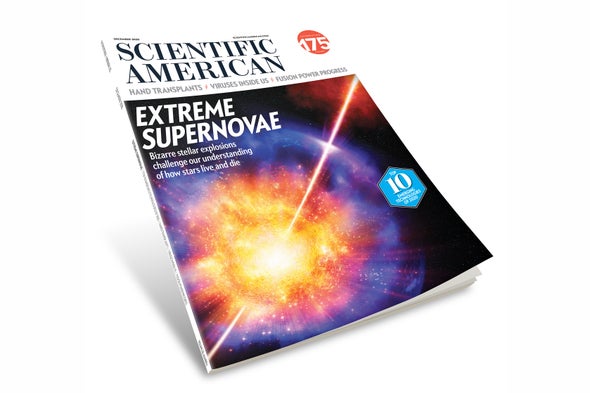One of the joys of being a science journalist is that it's your job to talk with people who are doing mind-bending and world-changing research and to ask them goofy questions. We ask them serious questions, too, of course, but we also encourage scientists to share the funny, tense, disappointing, surprising, human sides of their work. The goal is not to make an expert seem ridiculous but to demonstrate that we're all just people trying to figure out how to make sense of the world.
This month's cover story on new discoveries about how stars explode and die is an exciting look at a rapidly growing field that is studying phenomena at awesome time and size scales. But it's also a human drama about how Anna Y. Q. Ho had to sleep in a sleeping bag in a remote observing lab, wake up at 4 A.M. and race the dawn to get a reading on an exploding star 21 billion light-years away. See Explosions at the Edge for more about her pursuit of strange star endings.
One reason we urge scientists to show us the personal side of research is that we hope it demystifies what they do. Increasingly, we're seeing the danger of people rejecting scientific findings and claiming that certain fields are all a hoax or a conspiracy. It's distressing but mostly harmless when people fall for fake documentaries claiming the earth is flat. It's life-threatening when they fall for misinformation about the COVID-19 pandemic. Starting here, Filippo Menczer and Thomas Hills detail the ways conspiracy theories spread—including a disinformation campaign targeted at their own research group.
The delicate surgery required to transplant a hand is just the start of the process; the recipient must then relearn how to use it. The brain reroutes neural signals in many different areas, showing how nimble and adaptable it can be. Scott H. Frey describes how his early interest in neuroscience was inspired by his mother's multiple sclerosis and her loss of motor control. He shares this research starting here.
The human body is actually a superorganism teeming with bacteria, fungi and hundreds of trillions of viruses. The study of the human virome is only about a decade old, and the research is accelerating as scientists respond to SARS-CoV-2, the virus that causes COVID. These viruses aren't all bad. Some are harmless, and some might help treat diseases or fight antibiotic resistance. Turn here for David Pride's fascinating discoveries about the viruses that live in and among us.
The idea of an international collaboration to build a fusion reactor that could produce clean energy came out of a Superpower Summit in Geneva in 1985 featuring Ronald Reagan and Mikhail Gorbachev. Now the International Thermonuclear Experimental Reactor is being built. The project feels like a series of marathons, the ITER director tells senior editor Clara Moskowitz. Parts have been made all over the world, and beginning here, you can see the stunning facility coming together.
We're delighted to have editor in chief emerita Mariette DiChristina back in our pages this issue. Once again, she and the World Economic Forum teamed up with a steering committee of experts in a wide range of fields to highlight 10 emerging technologies. It's an inspiring package and a reminder that research and innovation have the potential to save and improve our lives.


